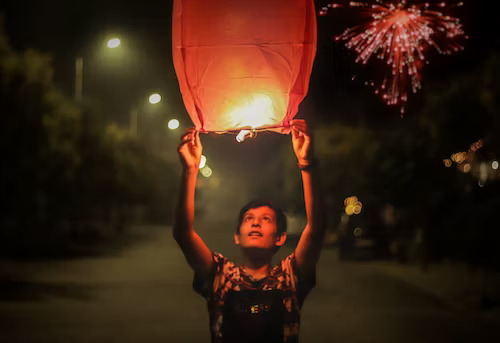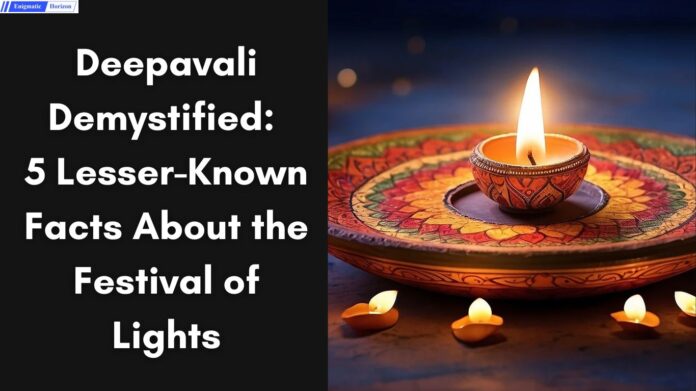Priyanka Bhattacharya (Sub Editor)
Diwali, a different acronym for Deepavali, has its roots in the rich fabric of Indian religious traditions and mythology. There are several tales about the origins of this occasion, which Indian communities all over the world and in India widely observe. The epic Ramayana describes the return of Lord Rama to Ayodhya following his successful battle against the demon king Ravana, and it is one of the most well-known and universally recognised legends. Deepavali, in all of its forms, is more than simply a holiday; it’s a unifying force that serves as a constant reminder of the importance of knowledge, the enduring power of light, and the ever-present battle between good and evil.

The Ultimate Guide to the Origin of Deepavali
1. The Lord Rama’s Return
The tale of Lord Rama returning to Ayodhya following his 14-year banishment and vanquishing the evil king Ravana is among the most popular and extensively commemorated tales linked with Deepavali. The inhabitants of Ayodhya, according to the epic Ramayana, lit lights and let off fireworks to welcome Rama’s return, and they also decorated their homes. This custom represents the triumph of light over darkness and the victory of good over evil.
2. The Lord Krishna’s Victory
Deepavali is observed in certain regions of India, especially in the southern states, to honour Lord Krishna’s conquest over the demon Narakasura. The Bhagavata Purana states that Lord Krishna freed 16,000 imprisoned princesses and vanquished the destructive Narakasura. This is commemorated as a victory for morality.
3. The King Bali Legend
Deepavali is connected to the stories of King Bali and Lord Vishnu’s Vamana avatar in several regions of India. Renowned for his magnanimity and loyalty, Lord Vishnu bestowed upon King Bali the gift of ruling the netherworld. However, Lord Vishnu, who took the form of Vamana, forced King Bali into the underworld on Deepavali. Every year, during Deepavali, King Bali makes his yearly visit to Earth from the netherworld.

4. Jain Light Festival
As the day that Lord Mahavira, the 24th Tirthankara of Jainism, attained nirvana, Deepavali holds great religious significance for Jains. On this day, Jains commemorate the propagation of spiritual truth and the eradication of ignorance by lighting lamps and celebrating with devotion.
5 Lesser-Known Facts About the Festival of Lights
1. Variations By Region
Deepavali is a kaleidoscope of regional variations and traditions across India. The beauty of this celebration lies in its diversity, where each region infuses its own unique flavour into the festivities. In North India, it is primarily associated with Lord Rama’s return to Ayodhya, while in the South, it’s dedicated to Lord Krishna’s victory over the demon Narakasura. In Bengal, the focus is on the goddess Kali, and in some Western states, the day is devoted to worshipping cattle. The cultural richness of Deepavali is a testament to India’s vast and varied heritage, showcasing how this luminous festival can adapt to the local customs and beliefs while still uniting the nation in the spirit of light and joy.

2. Varies According To The Moon’s Position
Deepavali is a dynamic and ever-changing event because of its close relationship to the Hindu lunar calendar. It’s based on the lunar month of Kartik, on the night that is the darkest (Amavasya) of the month that follows. Every year, Deepavali shifts in conjunction with the moon’s position, signifying the triumph of light over darkness. The celebration gains spiritual importance, marks the beginning of a new lunar year, and invites people to embrace its bright symbolism by aligning with the cosmic rhythms of the universe.
3. A Special Day For Cows
In addition to the customary celebrations, Deepavali incorporates a unique day called “Gaupuja” or “Cow Puja” that is devoted to honouring cows. This unusual custom, which is mostly followed in the state of Odisha, emphasises great regard and adoration, and the day after Deepavali is dedicated to bathing cows, painting their horns in vivid colours, and decorating them with garlands of colour. They are provided specially prepared meals and are revered with great devotion. This tradition represents the essential function cows provide in farming and rural communities.
4. Diwali Betting
Playing cards and gambling is a fascinating custom in some parts of India during Deepavali, which may appear inconsistent with the festival’s spiritual and joyous essence. This custom stems from the notion that on this auspicious day, Goddess Parvati and her husband, Lord Shiva, played dice. The games have social and recreational value, but they also have a spiritual component, as players feel that good fortune and luck in these games represent blessings for the next year. As a result, it serves as a fun method to bring families and friends together.

5. Deepavali: a New Year for Many
Deepavali has special meaning in the state of Gujarat as it is the start of the new year based on the ancient Hindu calendar known as the Vikram Samvat. “Gujarati New Year,” or “Bestu Varas,” is the name given to this year-end ceremony. On this day, families clean their homes completely, get dressed in new clothing, and go to temples to ask for blessings for the upcoming year. This distinctive feature of Gujarat gives the celebration a feeling of renewal and optimism by highlighting the significance of starting afresh.
These provide depth and diversity to our understanding of Deepavali, highlighting the festival’s cultural, historical, and global dimensions. They also highlight the festival’s diverse and ever-evolving nature by highlighting its cultural, environmental, and historical facets beyond the well-known aspects of the celebration.
